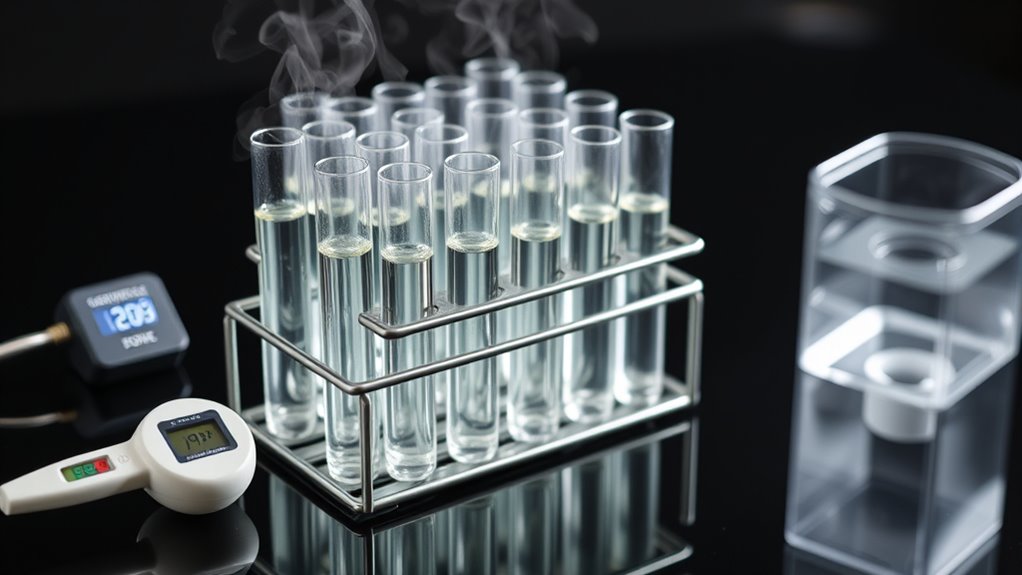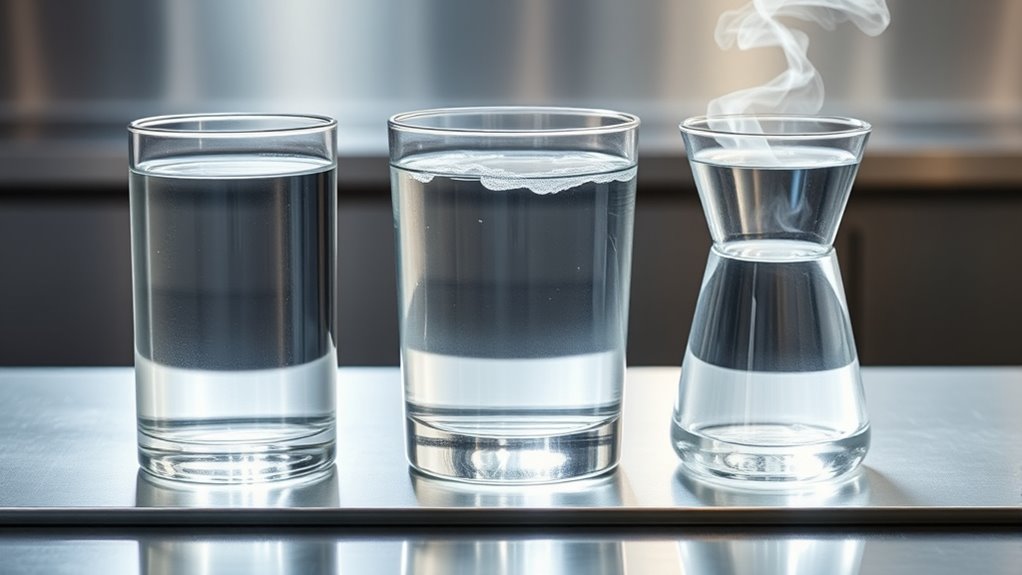When choosing containers for temperature-sensitive items, you should run three key heat-shock tests. First, expose them to rapid temperature changes to see if they crack or warp. Second, test their insulation effectiveness by simulating sudden thermal shocks, ensuring they protect contents. Third, evaluate their durability against repeated thermal cycling to prevent eventual failure. Conducting these tests helps you select containers that can handle real-world conditions. Keep exploring to find out how to perform these tests effectively.
Key Takeaways
- Conduct rapid temperature cycling tests to evaluate container durability during sudden heat or cold exposure.
- Assess material compatibility by exposing containers to thermal shocks to prevent cracking, warping, or degradation.
- Verify insulation effectiveness in buffering temperature changes to protect sensitive contents during thermal stress.
- Ensure containers can withstand multiple heat-shock cycles without failure for reliable long-term use.
- Match container materials and insulation properties to specific storage needs based on heat-shock test results.

Choosing containers is crucial to guarantee your items stay protected and organized. When selecting storage solutions, you need to consider several factors, especially material compatibility and container insulation. Material compatibility ensures that your items won’t be damaged by the container itself, whether that’s due to chemical reactions, corrosion, or degradation over time. For example, if you’re storing food, plastics that are food-grade and resistant to oils or acids are necessary. For chemicals or sensitive electronics, metal or specific plastics may be more appropriate. Always check the material specifications to match your items’ needs, avoiding containers that could cause contamination or deterioration. Additionally, understanding the natural materials used in farmhouse decor can help inform choices about container aesthetics and synergy with your overall design.
Container insulation is equally important, especially if your items are temperature-sensitive. Insulated containers help maintain a stable environment, protecting contents from extreme heat, cold, or rapid temperature changes. This is particularly important if your items are perishable, fragile, or require specific temperature ranges. When running heat-shock tests, you’ll simulate sudden temperature fluctuations to see how your containers perform. Proper insulation minimizes the risk of thermal stress, which can crack or warp containers and damage the contents inside. Choosing containers with adequate insulation also helps in scenarios where storage conditions fluctuate unexpectedly, such as during transportation or in varying climate zones.
Before conducting heat-shock tests, you should evaluate whether your current containers are suitable for the stress they’ll face. The test involves exposing containers to rapid temperature changes, so you need to assess their material compatibility with thermal cycling. Some plastics, for instance, might become brittle or warp under sudden heat or cold, indicating poor material compatibility. Insulated containers with high-quality thermal barriers tend to withstand these shocks better, but it’s essential to verify their specifications. You might find that some containers, despite being insulated, aren’t designed to endure extreme temperature swings, which could lead to failure during testing.
In practice, you’ll want to select containers that not only match your storage requirements but also demonstrate resilience during heat-shock tests. This means choosing materials that can handle thermal stress without cracking or degrading, and ensuring the insulation is sufficient to buffer rapid temperature changes. By carefully evaluating these aspects, you can identify containers that will perform reliably under challenging conditions, ultimately protecting your items and extending their lifespan. Remember, the goal is to simulate real-world stresses so you can choose containers that won’t fail when subjected to sudden temperature shifts, giving you peace of mind in storage and transportation situations.
Frequently Asked Questions
What Materials Are Best for Heat-Shock Containers?
When selecting materials for heat-shock containers, you should prioritize those with good material compatibility and strong insulation properties. Metals like stainless steel or aluminum are durable and resistant to thermal stress, making them ideal. Insulating materials such as foam or fiberglass help maintain temperature stability during tests. You need containers that can withstand rapid temperature changes without degrading, ensuring your heat-shock tests are accurate and safe.
How Do Temperature Ranges Affect Container Durability?
Temperature ranges directly impact your container’s durability by influencing thermal expansion and material fatigue. When exposed to extreme temperature shifts, materials expand and contract, which can cause cracks or weaken the container over time. Staying within a suitable temperature range minimizes these effects, ensuring your container remains intact and functional. Properly managing temperature fluctuations helps prevent damage caused by repeated thermal stress, extending the lifespan of your container during heat-shock testing.
Can Containers Be Reused After Heat-Shock Testing?
Think of your containers like brave soldiers after a heat-shock test—some stand tall, ready for battle again, while others show cracks. Reusing depends on their resilience; if they pass the durability battle, you can recycle them following proper protocols. Recycling protocols and material recycling guarantee you give these containers a second life, reducing waste and conserving resources. Always inspect thoroughly before reuse to keep your process safe and sustainable.
What Safety Precautions Are Needed During Testing?
During heat-shock testing, you need to prioritize safety by wearing appropriate personal protective equipment like heat-resistant gloves and goggles. Always follow emergency shutdown procedures in case of equipment failure or unexpected hazards. Confirm your workspace is clear of unnecessary objects and that you’re familiar with safety protocols. Staying alert and prepared helps prevent accidents, ensuring both your safety and the integrity of the test process.
How to Select the Appropriate Container Size?
Imagine your container as a vessel of possibilities, guiding your choices. To select the right size, consider the container capacity needed for your samples and guarantee it matches the test’s scale. Material compatibility is essential; your container should withstand rapid temperature changes without reacting. Measure your sample volume accurately, then choose a container that offers enough room for expansion and safety, securing reliable and safe heat-shock testing.
Conclusion
Now that you’ve mapped out your containers and understand the heat-shock tests, you’re ready to set sail on your experiment journey. Think of your containers as tiny ships braving temp storms, each one built to withstand the fiery seas. With confidence as your compass, you’ll navigate these tests smoothly, discovering which vessel holds up best under pressure. Embrace the adventure ahead—your perfect container is waiting to prove its resilience in the heat’s fierce embrace.
















